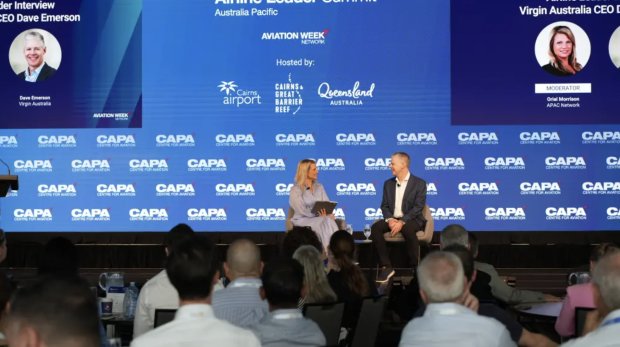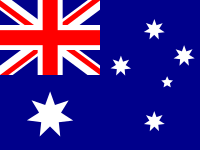CAPA Airline Leader Summit Asia Pacific 2025: Key Highlights Summary

The CAPA Airline Leader Summit Asia Pacific 2025 in Cairns featured a stellar lineup of high-level speakers and panellists covering a wide range of critical industry topics. These highlights cover a selection of the key insights from the packed agenda of in-depth interviews, keynote presentations and expert panel discussions.
For full coverage of the CAPA Airline Leader Summit Australia Pacific and more, visit the CAPA - Centre for Aviation website or add the CAPA Events category to your custom news Alerts.
Summary
- Highlights from the 2025 CAPA Airline Leader Summit Australia Pacific in Cairns.
Airline Leader Interview: Virgin Australia CEO Dave Emerson
Strategic Focus:
- The airline targets the value segment, specifically small businesses, value-oriented corporates, and premium leisure travellers.
- Current domestic market share is approximately one-third, which aligns with the strategic vision.
- Growth strategy focuses on winning more share within core customer segments rather than expanding to new segments.
Recent Milestones:
- Successful transition to public company status through IPO, with Qatar Airways acquiring 25% ownership.
- Launch of international flights to Doha in partnership with Qatar Airways.
- Implementation of employee stock ownership programme.
Fleet and Operations:
- Aggressive fleet renewal programme with 16 aircraft scheduled for delivery in the current fiscal year.
- Fleet expansion includes 12 new Boeing 737 MAX aircraft and Embraer E-Jets E2 aircraft for Western Australia routes.
- Company has grown from 58 aircraft post-administration to over 100 currently.
- Funding fleet expansion through strong cash flow without raising additional capital.
Future Plans:
- Testing long-haul operations through Qatar partnership before potential direct investment.
- Continuing technology investments to transform from competitive parity to competitive advantage.
- Planning to introduce pets on board before year-end after regulatory hurdles are cleared.
- Transformation agenda expected to continue for several more years.
Competitive Positioning:
- Virgin's culture and people are viewed as key competitive differentiators.
- Focus on maintaining operational performance while enhancing customer experience.
- Long-term growth expected to align with industry trends as travel demand continues to increase.
Panel: Managing risk in a volatile global climate
- Australian Capital Territory Chief Minister Andrew Barr
- Australian Competition and Consumer Commission GM Matthew Schroder
- Cairns Airport CEO Richard Barker
- Virgin Australia CFO Race Strauss
Strategic Partnerships and Competition:
- The ACCC approved the Qatar-Virgin strategic partnership, which will enable a daily flight from Canberra to Doha starting December, benefiting regional airports and consumers.
- Virgin's partnership with Qatar Airways provides access to 170 international destinations, Velocity frequent flyer benefits, and brings approximately $3 billion to the Australian economy.
- Industry leaders emphasised that competition is beneficial for consumers, but partnerships need to be sustainable for airlines to remain viable.
Business Challenges and Risk Management:
- Major risks identified include geopolitical instability affecting fuel prices, technology changes including AI, environmental concerns, and demographic shifts in key markets.
- Virgin Australia has implemented strict financial discipline, shutting down long-haul, Tigerair Australia and freight businesses to maintain competitive cost structures.
- Airports are diversifying international markets served to mitigate risks, particularly reducing over-reliance on China while maintaining it as an important partner.
Virgin Australia's IPO Journey:
- Virgin Australia's IPO process faced multiple challenges including market timing issues, the Qatar deal, 'Liberation Day' market disruption, and conflicts on launch day.
- Despite these obstacles, the IPO was oversubscribed.
Industry Concerns:
- Cybersecurity emerged as a significant concern, with continuous sophisticated attacks requiring substantial investment in protective measures.
- Airport pricing was highlighted as a major cost factor for airlines, with calls for mandated aeronautical pricing principles and a negotiate-arbitrate model.
- Aircraft availability constraints are affecting route development and pricing, with maintenance costs rising due to extended fleet usage.
CAPA State of the Industry
- CAPA - Centre for Aviation head of research Simon Elsegood
Domestic Market Structure:
- The Australian domestic market is highly concentrated, with two major airline groups dominating 95% of the market.
- The two big dominant airline groups handled 95% of passengers in 2024. 90% of Australian domestic passengers have a choice of two airline groups.
Workforce Shortages:
- The aviation industry is facing significant workforce shortages, particularly in airport and maintenance roles, with an aging workforce and competition from overseas markets exacerbating the issue.
- A gap has emerged of about 800 to 10,000 workers, primarily in airports and maintenance
- The industry is recruiting fewer young people, so the workforce is going to continue to age.
Sustainability Challenges:
- Aviation emissions are growing as a proportion of Australia's total emissions, with sustainable aviation fuel (SAF) adoption lagging due to limited local production.
- Australian airlines consumed eight billion litres of jet fuel in 2024 and burned 10 million litres of SAF, which was all sourced overseas.
Golden Triangle Airports Recovery:
- Major Australian airports are still recovering, with Sydney most impacted, while Perth shows significant growth due to increased international traffic and regional travel.
International Market Trends:
- While some traditional markets like New Zealand and the US are still down, there's strong growth in Southeast Asian destinations and emerging European markets.
Business Travel Decline:
- There is a structural decline in business travel post-pandemic, with video conferencing and corporate policies impacting demand.
Fleet Supply Constraints:
- Airlines are facing challenges in acquiring new aircraft due to global supply chain issues, impacting capacity growth and network expansion.
- Airlines have not been able to get the aircraft that they want to increase capacity and grow their networks. OEMs are still struggling to lift production.
Passenger Recovery Post-COVID:
- The Australian aviation industry is showing strong recovery from COVID-19 impacts, with international travel rebounding faster than domestic.
Airfare Trends:
- After a period of elevated prices, both domestic and international airfares are showing a downward trend due to increased capacity and competition.
- There were substantially higher fares in 2023 and into 2024, but fares have started to normalise.
Long-Term Growth Projections:
- The Australian aviation market is projected to add 40 million passengers over the next decade.
- The domestic market will account for two thirds to three quarters of passengers, with growth of 2% to 2.5%. The international market has more growth upside at 2.5% to 3%, based on conservative estimates.
Airline Leader Interview: Air New Zealand, CCO, Jeremy O'Brien
Air New Zealand recently announced Nikhil Ravishankar as its next CEO. Described as "constantly curious" and "a real innovator," Ravishankar brings significant digital expertise to the role. Having served at the airline for over five years, he has focused on enhancing customer experiences and operations through digital technology and introduced an agile operating model that has improved the organisation's responsiveness to change.
The airline has faced significant operational challenges, with up to 11 aircraft grounded simultaneously due to engine issues. To maintain network integrity, Air New Zealand implemented several solutions, including:
- Leasing three Boeing 777s from Cathay Pacific.
- Securing 15 additional Pratt & Whitney engines.
- Receiving new A321neo deliveries.
These measures have enabled the airline to resume growth, particularly across the Tasman Sea where it will operate 1.7 million seats during the winter season - a 10% year-on-year increase. The airline is also expanding services to Pacific Islands and domestic routes.
Fleet expansion continues with ultra-long-haul Boeing 787s arriving in February and March 2026, featuring increased premium cabin density to target the premium leisure market, particularly from the US.
The airline is innovating with its SkyNest product - six bunk beds between premium economy and economy cabins that passengers can book for four-hour sleep periods on ultra-long-haul flights. This reflects Air New Zealand's commitment to addressing customer pain points through innovation.
Regarding network strategy, Air New Zealand is evaluating potential returns to London and Chicago markets and exploring opportunities in India through partnerships. The carrier is taking a more rational approach to route selection post-COVID, focusing on markets where it has "the right to win" and can achieve sustainable returns.
Panel: Sustainability: Making the net-zero vision a reality
- Air New Zealand chief sustainability and corporate affairs officer Kiri Hannifin
- Boeing sustainability lead - Australia, New Zealand and South Pacific Kimberly Camrass
- Qantas Group chief sustainability officer Fiona Messent
- Tourism & Transport Forum CEO Margy Osmond
- Virgin Australia chief corporate affairs and sustainability officer Christian Bennett
Current Challenges and Approaches:
- Airlines are shifting from carbon intensity metrics to net emissions measurements.
- The next five years are deemed critical for meeting 2030 reduction targets.
- Industry consensus that airlines cannot achieve decarbonisation alone - partnerships across the entire ecosystem are essential.
Policy and Economic Considerations:
- Harmonised policy frameworks across regions are preferred to avoid fragmentation.
- Sustainable Aviation Fuel (SAF) development presents significant economic opportunities, potentially adding to GDP and creating jobs.
- Learning from international policy implementations is crucial for Australia and New Zealand to design effective frameworks.
Cost Distribution and Financing:
- The "green premium" of SAF (currently 3-4 times more expensive than conventional fuel) requires sophisticated cost-sharing mechanisms.
- Book and claim systems (separating physical fuel from environmental attributes) could help aggregate demand.
- Defence procurement and corporate partnerships are emerging as important demand signals.
Broader Benefits Beyond Emissions:
- SAF development offers fuel security benefits, reducing dependence on imports.
- Rural communities could benefit from agricultural feedstock production, creating regional jobs.
- Tourism industry faces significant economic risks if aviation sustainability isn't addressed.
Carbon Offsets and Physical Climate Impacts:
- High-integrity carbon credits remain essential for net-zero strategies.
- Physical climate impacts already affecting aviation operations through extreme weather events.
- Tourism destinations face infrastructure challenges from rising temperatures and severe weather.
The panel emphasised that sustainability messaging should focus on economic opportunities rather than solely on climate risks, and that the entire tourism ecosystem must collaborate on solutions rather than leaving the burden solely with airlines.
Airline Leader Interview: Qantas Domestic CEO Markus Svensson
Fleet Renewal and Aircraft Acquisition:
- Qantas has taken delivery of its first A321XLR aircraft, with three expected before Christmas 2025 and seven by June 2026.
- The A321XLR offers significant customer benefits including 60% more overhead locker space and operational efficiencies through fuel savings.
- The airline is undergoing a major fleet transition, which was identified as a critical challenge to manage effectively.
Project Sunrise:
- This initiative aims to be able to connect any point on the globe with non-stop flights.
- First aircraft is being manufactured in France with delivery expected in 2026.
- First Sunrise flight anticipated in 2027.
- Customer experience will include specialised rest zones for economy passengers and carefully designed service timing.
Sustainability Initiatives:
- Sustainable Aviation Fuel (SAF) is viewed as the primary solution for reducing carbon footprint.
- This presents challenges but the industry must "earn the right to travel".
Business Recovery and Challenges:
- Post-COVID operational recovery has been the biggest challenge, including getting aircraft out of storage and finding skilled workers.
- Business travel is returning, though at different rates across sectors.
- Customer expectations have increased post-pandemic, with time becoming even more valuable to travellers.
Technology and Security:
- Qantas experienced a recent cyber incident but no passwords, credit card details or passport information was compromised.
- The airline is investing in AI and technology across operations, including crew scheduling, flight planning and customer service.
- Legacy systems remain a challenge for the industry.
Mr Svensson expressed optimism about the future of air travel, noting that people continue to prioritise travel despite financial pressures.
This summary was generated with AI assistance. All content was verified before publication but some errors may remain. For full coverage of the CAPA Airline Leader Summit Australia Pacific and more, visit the CAPA - Centre for Aviation website or add the CAPA Events category to your custom news Alerts.


